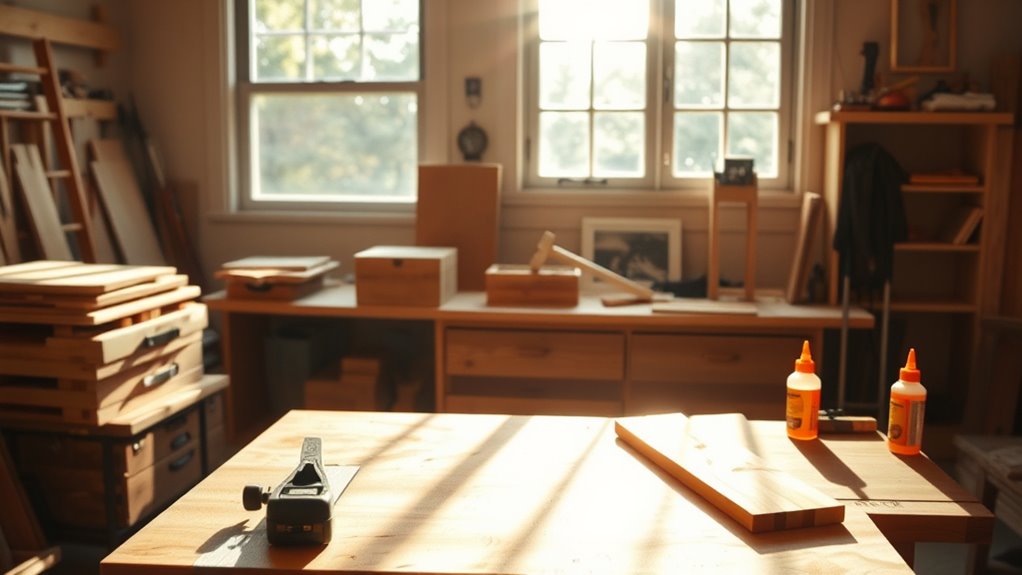Starting with simple woodworking projects like a wooden box or a basic shelf is perfect for building your skills. Use essential tools like a tape measure, handsaw, and square, and always prioritize safety by wearing glasses and staying organized. Focus on accurate measurements and take your time with each step. Practice regularly and don’t worry about mistakes—they’re part of learning. Keep going, and you’ll discover more tips to become confident in your woodworking journey.
Key Takeaways
- Start with basic projects like a wooden box or shelf to practice measuring, cutting, and assembling skills safely.
- Use simple tools such as a tape measure, hammer, screwdriver, handsaw, and square for accurate results.
- Follow clear instructions and double-check measurements before cutting or assembling to ensure precision.
- Prioritize safety by wearing safety glasses, keeping the workspace clean, and handling tools properly.
- Embrace mistakes as learning opportunities to build confidence and improve craftsmanship gradually.

Getting started with woodworking can be both exciting and rewarding, even if you’re a complete beginner. The first step is understanding the importance of woodworking safety. Before you pick up any tools, take the time to learn how to protect yourself. Always wear safety glasses to shield your eyes from flying debris, and consider ear protection if you’re working with loud power tools. Keep your workspace clean and well-lit to prevent accidents, and never rush through a project. Focusing on safety not only keeps you safe but also helps you develop good habits that will serve you well as you progress.
Prioritize safety with goggles, ear protection, and a clean workspace to build good habits and enjoy woodworking confidently.
Next, familiarize yourself with basic carpentry tools. As a beginner, start with simple, versatile tools that will serve most projects. A tape measure, hammer, screwdrivers, a handsaw, and a square are essential. These tools will allow you to cut, measure, and assemble your projects with confidence. When choosing tools, opt for quality, as they tend to be more reliable and safer to use. Learning how to handle each tool correctly is *vital*, so spend some time practicing and reading instructions. For example, understanding how to hold a saw properly or how to use a square for accurate measurements will make your work easier and more precise.
Once you have your safety measures in place and your tools ready, start with small, straightforward projects that help you practice basic skills. Building a simple wooden box or a basic shelf can teach you how to measure accurately, cut cleanly, and assemble parts securely. As you work through these projects, focus on following instructions carefully and double-checking your measurements. This will help you develop a good eye for detail and improve your craftsmanship. Additionally, understanding the cycle of breakups can remind you of the importance of patience and perseverance as you learn and improve.
Throughout your early projects, don’t be discouraged by mistakes. They’re part of the learning process. Take the time to understand what went wrong and how to fix it. Over time, your confidence will grow, and you’ll find yourself tackling more complex projects. Remember, patience and practice are key. The more you work with your basic carpentry tools, the more comfortable and skilled you’ll become. Keep safety at the forefront, and enjoy the process of turning raw wood into something useful and beautiful. With persistence, you’ll develop a solid foundation in woodworking that will enable you to take on more ambitious projects in the future.
Frequently Asked Questions
What Safety Gear Should I Always Wear When Woodworking?
You should always wear protective eyewear to shield your eyes from dust, chips, and debris, and hearing protection to prevent damage from loud tools. Never skip these safety gear items, even during simple projects. They keep you safe from potential injuries and long-term damage. Always double-check that your protective equipment fits properly and is in good condition before starting any woodworking task. Your safety comes first.
How Do I Choose the Right Wood for My Project?
Don’t put all your eggs in one basket when choosing wood; instead, consider your project’s needs. Think about wood type selection and how the grain patterns will look in your finished piece. For furniture, go for hardwoods like oak or maple for durability. For decorative accents, softer woods like pine work well. Match the wood’s characteristics with your project’s purpose to make certain it turns out just right.
What Are Common Mistakes Beginners Make in Woodworking?
You often make mistakes like measuring errors or improper joinery, which can compromise your project. To avoid these, double-check your measurements before cutting, and take your time fitting pieces together. Use the right tools for joinery and follow instructions carefully. Don’t rush—patience helps prevent errors. Practice precision and learn from each project, so your skills improve and your woodworking turns out just as you want.
How Do I Maintain and Store My Woodworking Tools?
To keep your woodworking tools in top shape, focus on tool organization and proper storage. Store your tools in designated, dry spaces to prevent rust and damage. Regularly sharpen your blades and chisels using effective sharpening techniques to maintain their edge. Keep tools clean and dry after use, and consider using blade guards or tool racks for safety. Proper maintenance guarantees your tools stay sharp, functional, and ready for your next project.
Can I Start Woodworking With Limited Space at Home?
Yes, you can start woodworking in a small workspace by choosing compact tools designed for limited spaces. Opt for versatile, multi-function tools that save room and keep your setup organized. Use wall-mounted storage or vertical shelving to maximize space efficiency. Focus on small projects that don’t require large equipment. With careful planning and the right tools, you’ll be able to develop your skills comfortably, even in a limited area.
Conclusion
Now that you’ve explored these simple projects, you’re ready to start building your skills and creating your own woodworking masterpieces. Remember, every expert was once a beginner—so don’t be afraid to make mistakes along the way. With patience and practice, you’ll turn basic pieces into beautiful, functional items. Are you excited to see what you can create with just a little wood and a lot of determination? Your woodworking journey starts today—what will you build first?








